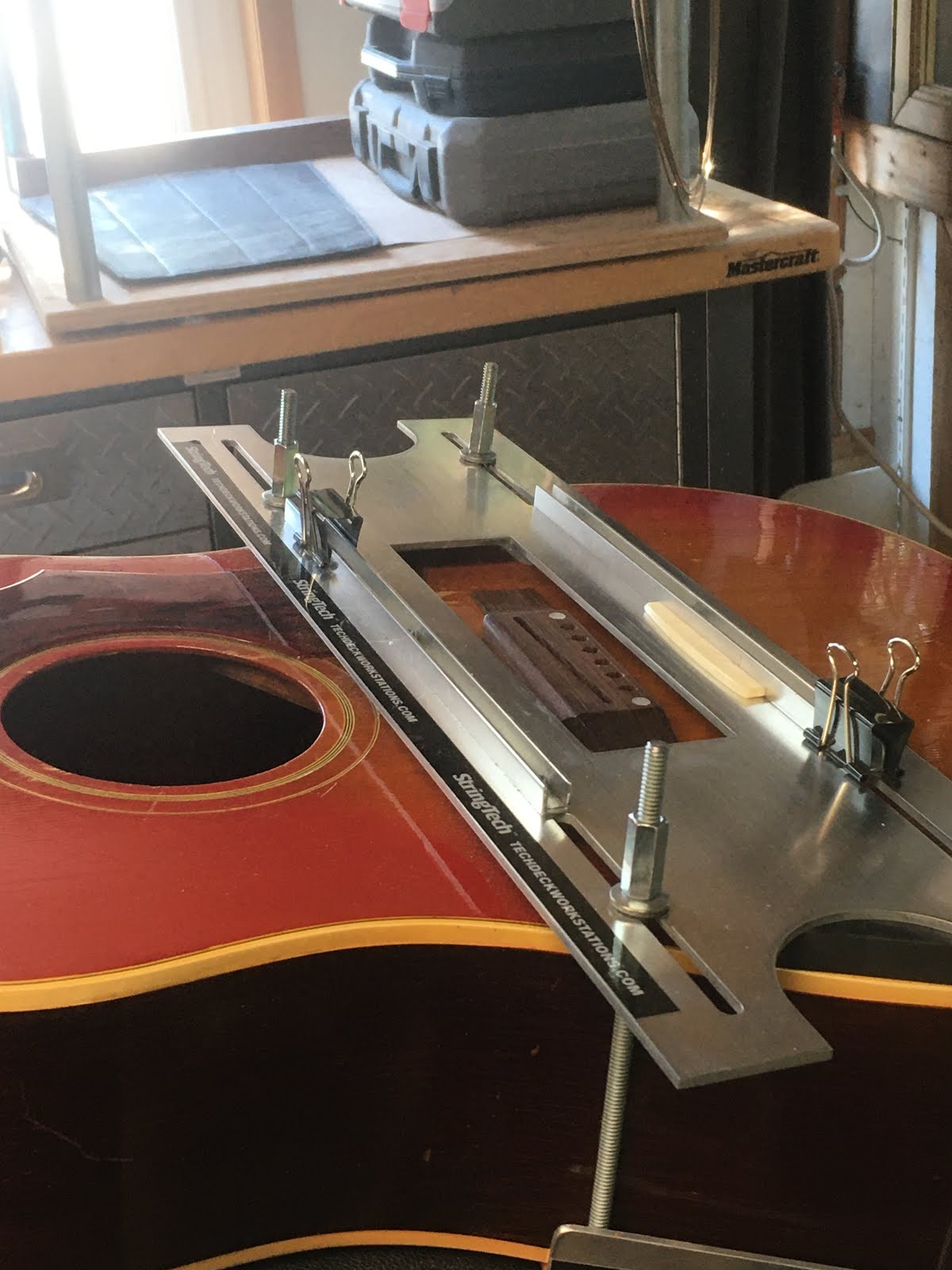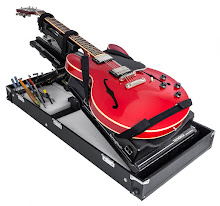Everyone has an electronic guitar tuner ....
but is that really enough to keep your guitar in tune ?
Try playing your garden variety first position "G" chord after tuning with your tuner. Follow this by a first position "D" chord. Is that F# on the second fret of the first string in tune ?
http://mcconvilleguitars.blogspot.ca/p/compensated-nuts-in-nutshell.html
The point I'm trying to make ... is that there isn't any one fix, that will correct your tuning issues.
You need to take a number of things into account to "setup " and intonate ( regulate ) your
guitar so that it is perfectly in tune !
but is that really enough to keep your guitar in tune ?
Try playing your garden variety first position "G" chord after tuning with your tuner. Follow this by a first position "D" chord. Is that F# on the second fret of the first string in tune ?
http://mcconvilleguitars.blogspot.ca/p/compensated-nuts-in-nutshell.html
The point I'm trying to make ... is that there isn't any one fix, that will correct your tuning issues.
You need to take a number of things into account to "setup " and intonate ( regulate ) your
guitar so that it is perfectly in tune !
Please take the time to read through this post several times to absorb the message. If you do so, you will be rewarded with a much greater understanding of exactly what you need to be aware of in order to keep your guitar perfectly in tune across the entire span of the fingerboard and playing as smooth as silk.
Intonation:
Setting intonation is one of the most commonly misunderstood / misinterpreted aspects of proper stringed instrument maintenance.
When "setting the intonation" or "regulating the tuning" so that the instrument plays in tune with itself across the entire register; there are several factors that need to be taken into consideration.
All of the following actions / considerations will affect the accuracy of the intonation.
The travel distance for each string saddle on the Strat (below) allows you to "compensate"
the length of the string to off-set the sharpening effect that happens when you pull the string
down to contact the fret.
Although the 12 fret is the halfway point ( theoretically )
between the nut and the contact point of the string at the bridge; the actual distance is slightly longer
to allow for that "stretching motion"of the string
that happens, when you pull the strings
down to contact the frets.
Although the 12 fret is the halfway point ( theoretically )
between the nut and the contact point of the string at the bridge; the actual distance is slightly longer
to allow for that "stretching motion"of the string
that happens, when you pull the strings
down to contact the frets.
This "movable string saddle" is typical for most electric guitars.
The solid bone Taylor 12-string saddle ( scroll down ) needed to be carved
in order to intonate ( alter the length ) of each of the 12 strings.
#1 String Gauge:
The most common error that customers unknowingly make, is to arbitrarily change gauges of strings.
For the most part, stringed instruments are generally comprised of organic ( wood ) components / neck and body.
The strings, on the other hand, generate a very exact "mechanical force".
Flip over the next package of D'Addario strings you purchase and you'll find the "lbs torque" that each string generates at concert pitch. You can add up the exact amount of load that those strings generate (individually or in total ) when tuned to concert pitch.
( Thank you ... D'Addario ! )
You need not concern yourself with the "exact math" as far as string load is concerned. But you do need to settle on exactly what string gauge that you plan on sticking with forever.
It is not a matter of right or wrong or better or worse when it comes to string gauge choice. You just need to make the decision ... and stick with it !
When the mechanical force of the strings is exerted on the organic
( wood ) components of the instrument ... the instrument will "flex" under the strain of the string load.
Once the instrument has "flexed and found it's equilibrium" to resist the exact load of the strings that you have chosen ... it will hold in this "flexed position"... essentially "floating in resistance" against that mechanical load of the strings.
Depending on the gauge of string you choose, the load can vary tremendously from 90 LBS - 165 LBS +.
To further complicate matters; if you use various tunings on the one guitar ..... the load can easily shift by + or - 35lbs-50lbs .
So ... once you have determined exactly what gauge of string and tuning that you'll be using on this particular guitar .... you will be ready to start the intonation process.
This is why .... after getting an instrument set up ..... you need to stick with the exact same gauge of strings and tuning, when you go to install a fresh set. If you don't; then all the minute adjustments and finessing that was done previously by your Guitar Tech...will go right out the window!
In summary: Once these values have been established, you are now ready to begin the various adjustments needed, in order to regulate the intonation.
Part #2 / #3 Lay of the Neck / Action:
The lay of the neck has a direct affect on the playability and intonation. In many cases, the neck may be adjusted by the "truss rod ".
The torque of the string load pulls the neck up and raises the action .... when this becomes extreme, the guitar becomes physically unplayable. Even if you have the "brute strength " in your fretting hand to play with that high action ; the amount of force you exert to bring the string into contact with the fret; will pull the intonation "progressively sharper" as you ascend the fingerboard.
When you tighten the truss rod , it counter-acts the pull of the strings and straightens the neck, which brings the string action back down, closer to the frets.
When an instrument is set up properly, it should take the same amount of fretting pressure to produce a note anywhere along the length of the neck.
Intonated Acoustic Guitar Bridge Saddle -Taylor 12 String
Once all three of these values .... string tension / lay of the neck / action height ..... have been established; then you are ready to move on to the next stage of adjustments that will regulate the intonation.
#4 Fretwork:
In order for an instrument to play to its' maximum potential, often times some fret work needs to be performed.
If you don't address the inconsistencies in the frets, then your only option is to hike up the action until the buzzing or "splatting-out notes" go away.
When you arbitrarily hike up the action to eliminate the fret problems; all of the previously mentioned adjustments ... lay of the neck / action / intonation / string gauge / special tunings etc / .... with all be thrown off !
I am not suggesting that you start experimenting with the frets. You either understand completely or you don't; no half measures here.
I cover this subject in great detail on my Patreon Channel
If frets are the issue ... go to a qualified Guitar Tech or Luthier
When you sight the neck along its length from the nut to the last fret
( close one eye ... it'll help ), you'll often see a bit of a "ski-jump" or "Hump"
at the neck-to-body junction. The truss rod will do nothing to correct this .
Your Guitar Tech or Luthier will need to either dress ( level /recrown / polish )
those upper frets or remove the frets, level the fingerboard and refret.
( close one eye ... it'll help ), you'll often see a bit of a "ski-jump" or "Hump"
at the neck-to-body junction. The truss rod will do nothing to correct this .
Your Guitar Tech or Luthier will need to either dress ( level /recrown / polish )
those upper frets or remove the frets, level the fingerboard and refret.
Often times ( with the advent of the higher fret wire profiles ... tall and jumbo )
it is possible to take the inconsistencies in the "lay of the neck" out
by dressing the crowns of the upper frets so that the action can be lowered
to optimum playability without the upper notes "splatting out".
http://mcconvilleguitars.blogspot.ca/2010/04/gibson-trio-3-335s.html
it is possible to take the inconsistencies in the "lay of the neck" out
by dressing the crowns of the upper frets so that the action can be lowered
to optimum playability without the upper notes "splatting out".
http://mcconvilleguitars.blogspot.ca/2010/04/gibson-trio-3-335s.html
#5 Post Fretwork:
Once the fret work work has been completed and you drop the action down to where it plays nice and smooth ; you'll be amazed at how accurately the guitar intonates. The main reason, for more accurate intonation, is that you are now exerting the same amount of left hand fingering pressure, whether you are playing at the 3rd fret or the 11th fret. So the typical " tuning sharpness " that you get when the action is too high has now been corrected.
So you've now accomplished 2 goals ...
a guitar that plays easier and tunes more precisely !!
I hope this has helped to clarify why you may be having tuning problems ... and provided you with a better understanding to help find a solution for your particular problem ( s) .
Very best to all .... thank you for taking the time read this post,
Michael
Very best to all .... thank you for taking the time read this post,
Michael







